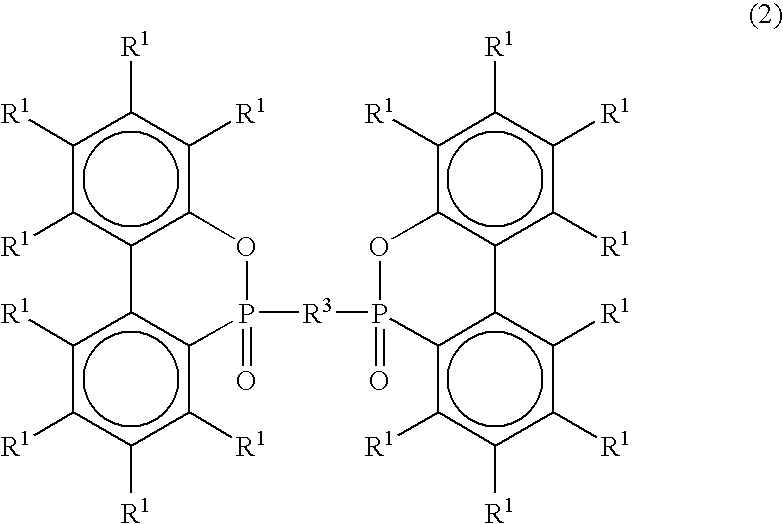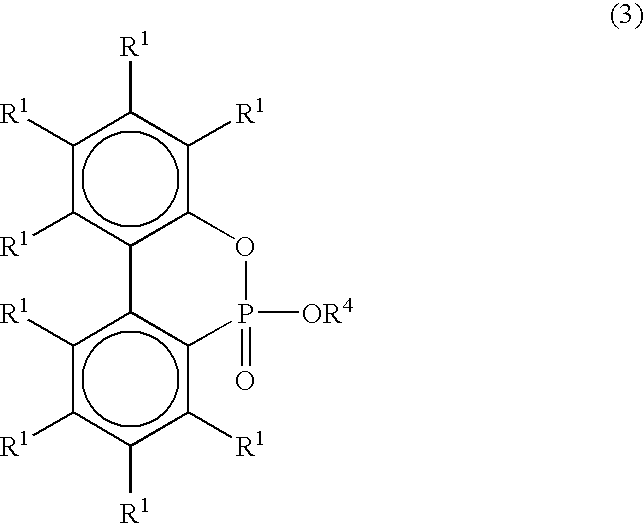Flame-retardant polyester-based fiber for artificial hair
a flame-retardant polyester and fiber technology, applied in the field of flame-retardant polyester artificial hair fibers, can solve the problems of inadequate heat resistance, inadequate flame resistance, and difficulty in availability of human hair, and achieve the effects of maintaining heat resistance and melt-drip-proof properties of fibers, sufficient flame resistance, and maintaining physical properties of fibers
- Summary
- Abstract
- Description
- Claims
- Application Information
AI Technical Summary
Benefits of technology
Problems solved by technology
Method used
Image
Examples
example
[0039] The present invention will, hereinafter, be described in still more details, referring to Examples, but the present invention is not limited to these Examples.
[0040] Measurement of physical property values was performed according to following methods.
(Strength and Elongation)
[0041] A filament was measured for a tensile elongation and strength using INTESCO Model 201 type made by INTESCO, Ltd. One filament with a length of 40 mm was sampled, both ends of the filament was sandwiched by 10 mm with cardboard (thin paper) with which double-stick tape having adhesives thereon was attached, and after air dried overnight, and a sample with a length of 20 mm was prepared. The obtained sample was clamped with a testing machine, examination was performed under conditions of temperature of 24 degrees C., not more than 80% of humidity, load 1 / 30 gf×size of a fiber (denier), and a speed of testing / minute of 20 mm, and tensile elongation and strength was determined. Examination was repe...
examples 1 to 16
[0048] A polyester pellet PESM6100 BLACK for coloring (manufactured by Dainichiseika Colour & Chemicals Mfg. Co., Ltd., 30% of carbon black contents: polyester content is included in the component (A) as polyester) 2 parts by weight was added to compositions having ratios shown in Table 1 comprising: a polyethylene terephthalate dried so as to have moisture content of not more than 100 ppm, phosphorus containing flame retardant agents, organic fine particles, and inorganic fine particles, and dry-blended. The obtained mixtures were delivered to a twin screw extruder, and were melt-kneaded at 280 degrees C. to be pelltized. And subsequently the pellets obtained were dried to not more than 100 ppm of moisture content. Subsequently, molten polymers were extruded from a spinneret having circle section holes of 0.5 mm of diameters of spinneret, using a melt spinning machine at 280 degrees C. The obtained filaments were cooled in a water bath with a water temperature of 50 degrees C. inst...
PUM
| Property | Measurement | Unit |
|---|---|---|
| length | aaaaa | aaaaa |
| length | aaaaa | aaaaa |
| length | aaaaa | aaaaa |
Abstract
Description
Claims
Application Information
 Login to View More
Login to View More - R&D
- Intellectual Property
- Life Sciences
- Materials
- Tech Scout
- Unparalleled Data Quality
- Higher Quality Content
- 60% Fewer Hallucinations
Browse by: Latest US Patents, China's latest patents, Technical Efficacy Thesaurus, Application Domain, Technology Topic, Popular Technical Reports.
© 2025 PatSnap. All rights reserved.Legal|Privacy policy|Modern Slavery Act Transparency Statement|Sitemap|About US| Contact US: help@patsnap.com



